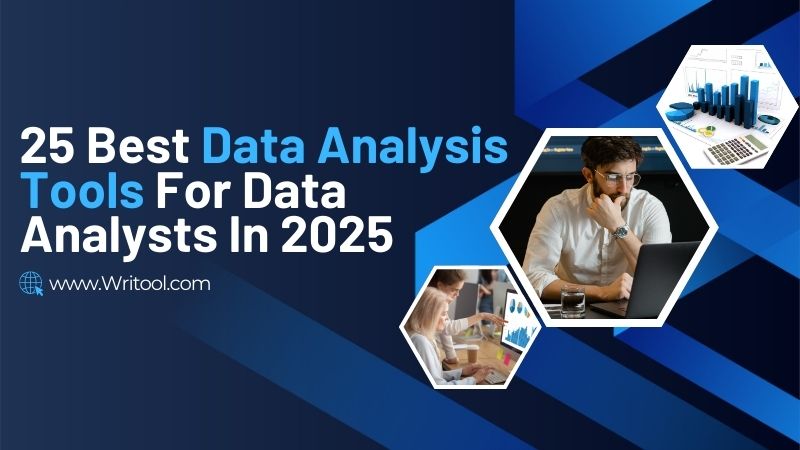In 2025, data analysis will remain at the heart of strategic decision-making, helping businesses harness actionable insights from complex datasets. As industries become increasingly data-driven, the demand for the best data analysis tools grows exponentially. With vast data volumes and the need for predictive accuracy, data analysts require robust tools to stay ahead in this dynamic landscape.
In this blog, we are going to discuss the 25 best data analysis tools of 2025, tailored to meet diverse analytics needs, from big data handling to machine learning and data visualization. Explore these cutting-edge solutions to elevate your analytical capabilities and productivity.
What is Data Analysis?
Data analysis involves examining, organizing, and interpreting raw data to uncover meaningful patterns, insights, and trends. It involves using statistical techniques, algorithms, and tools to transform complex datasets into actionable knowledge. This process aids in decision-making, predictive modeling, and problem-solving across industries.
In today’s data-driven world, data analysis is essential for understanding customer behavior, optimizing operations, and driving business growth. Analysts employ various methods such as descriptive, diagnostic, predictive, and prescriptive analysis to achieve their goals. Effective data analysis empowers organizations to make informed, strategic decisions, paving the way for innovation and efficiency.
Also Read:- YouTube Video Editing Tips For Beginners
What are Data Analysis Tools?
Data analysis tools are software or platforms designed to help users collect, process, and interpret data. These tools streamline intricate processes such as data cleaning, statistical analysis, data visualization, and predictive modeling. By automating and enhancing these processes, data analysis tools enable users to uncover patterns, trends, and insights quickly and accurately.
They range from basic spreadsheet tools to advanced machine-learning platforms. Popular examples include Excel, Tableau, and Python libraries like Pandas. These best data analysis tools are essential for data analysts, businesses, and researchers who need to transform raw data into valuable, actionable information for decision-making.
25 Best Data Analysis Tools For Data Analysts
A. Tools for Big Data Analytics
Apache Hadoop
An open-source framework designed to process large datasets across distributed computing environments, MapReduce uses the MapReduce programming model for data storage and processing. Thus, it is ideal for big data applications that require scalability, fault tolerance, and parallel computation.
Apache Spark
Spark is an in-memory processing engine for big data analytics. By performing computations in memory, it provides faster computation than Hadoop and supports batch and real-time processing. It’s widely used for machine learning, SQL querying, and graph processing, making it essential for big data applications.
Snowflake
A cloud-native data warehousing platform offering scalable data storage, sharing, and computing. It allows real-time data analysis with support for structured and semi-structured data. Snowflake’s architecture separates computing and storage, offering flexibility and scalability for growing datasets.
Databricks
A unified data analytics platform powered by Apache Spark, Databricks simplifies data processing and machine learning. It provides an integrated workspace for data engineers and data scientists to collaborate, analyze large datasets, and deploy machine learning models, enhancing productivity in big data environments.
B. Business Intelligence (BI) Tools
Tableau
Tableau is a leading data visualization tool that enables users to create interactive dashboards and reports. It connects to various data sources, providing drag-and-drop functionality to create visually appealing, shareable insights that simplify complex data analysis for users of all skill levels.
Power BI
Power BI is a Microsoft business analytics service that offers robust data visualization and reporting tools. It allows users to integrate data from various sources, create interactive reports, and share insights across teams. Its integration with Microsoft products makes it ideal for Office 365 users.
Qlik Sense
Qlik Sense is a self-service BI tool that uses an associative data model to help users explore and visualize data. It offers interactive dashboards and reporting, making data exploration intuitive and easy. Qlik Sense also supports collaborative decision-making through shared insights and real-time analysis.
Looker
Looker is a cloud-based BI platform that focuses on data exploration, reporting, and visualization. It uses a unique modeling language (LookML) to define business logic and metrics. Looker empowers teams to collaborate and share insights while delivering in-depth, customizable analytics.
Domo
Domo is a cloud-based BI tool that enables real-time data visualization, reporting, and collaboration. It offers a wide range of integrations, making it ideal for businesses that want to centralize and analyze their data in one place. Domo supports collaboration by allowing teams to share dashboards and insights.
C. Best Data Analysis Tools For Statistical Analysis
SAS
SAS is a comprehensive analytics platform used for advanced statistical analysis, business intelligence, and predictive analytics. It offers powerful tools for data management, statistical modeling, and machine learning, making it a preferred choice for large enterprises and industries like healthcare and finance.
R Programming
R is an open-source language developed for statistical analysis and data visualization. It is highly extensible and offers numerous packages for various types of data analysis, such as regression, clustering, and time series analysis. R is popular among researchers and statisticians for its flexibility and extensive resources.
SPSS
SPSS (Statistical Package for the Social Sciences) is a software suite used for statistical analysis in social science research. It’s widely used for data manipulation, hypothesis testing, and regression analysis. SPSS provides an easy-to-use interface, making it suitable for users without advanced statistical knowledge.
Stata
Stata is a statistical software package that offers tools for data analysis, management, and visualization. It is well-suited for analyzing complex datasets in fields like economics, sociology, and epidemiology. Stata is highly regarded for its powerful statistical capabilities and user-friendly interface.
JMP
JMP is a statistical discovery software developed by SAS, focusing on interactive visualizations and data analysis. It enables users to explore data visually, perform statistical modeling, and run simulations. JMP is widely used in scientific and engineering disciplines for its hands-on approach to data analysis.
D. Machine Learning Tools
TensorFlow
TensorFlow is an open-source machine learning framework created by Google. It is widely used for deep learning tasks such as neural network modeling. TensorFlow offers scalability, flexibility, and a vast community, making it one of the most popular frameworks for developing AI applications.
PyTorch
PyTorch is a flexible, open-source machine learning library primarily used for deep learning research and production. Developed by Facebook, it supports dynamic computation graphs, making it easier to work with complex models and ensuring high performance in real-time applications.
KNIME
KNIME is an open-source platform designed for data analysis, reporting, and integration. It allows users to build machine learning workflows through a graphical interface. KNIME’s integration capabilities with other tools, combined with its extensive set of algorithms, make it ideal for data science and machine learning projects.
RapidMiner
RapidMiner is a data science platform offering tools for data preparation, machine learning, and predictive analytics. It offers a drag-and-drop interface for building workflows and models, making it accessible to both beginners and experienced data scientists. RapidMiner also supports automated machine learning (AutoML).
Weka
Weka is an open-source data mining tool for machine learning and data mining tasks. It provides algorithms for classification, clustering, and regression tasks. Weka is popular for its user-friendly interface and is frequently used in academic research and small-scale machine-learning applications.
Google Cloud AI Platform
Google Cloud AI Platform offers powerful cloud-based machine learning tools for developing, training, and deploying models. It also provides access to pre-trained models, TensorFlow support, and scalable infrastructure for large datasets, making it suitable for both beginners and experienced practitioners.
E. Best Data Analysis Tools For Data Visualization
Google Data Studio
Google Data Studio is free for creating dashboards and reports. It integrates seamlessly with Google products such as Analytics, Google Ads, and BigQuery. Users can customize reports with charts, graphs, and tables, making them ideal for marketing and business analysis.
Microsoft Visio
Microsoft Visio is a diagramming tool used for creating flowcharts, org charts, and other visual representations of data. It helps in simplifying complex processes and creating visually appealing diagrams that support business decision-making and project management.
Sisense
Sisense is a business intelligence and data visualization tool that enables users to create interactive dashboards and reports. It is known for its ability to handle large datasets and provides an integrated platform for data analysis and visualization, enhancing business insights and decision-making.
Infogram
Infogram is an online data visualization tool that specializes in creating interactive charts, infographics, and reports. It allows users to transform data into visually engaging presentations, making it ideal for media, education, and marketing sectors that require easy-to-understand visual representations.
Zoho Analytics
Zoho Analytics is a cloud-based analytics and business intelligence platform that offers data visualization, reporting, and analysis tools. It supports integration with various data sources and provides advanced analytics features such as AI-powered insights, making it a powerful tool for businesses of all sizes.
Also Read:- Best Fonts For Mobile App Design
Factors to Consider While Choosing a Data Analysis Tool
When selecting the best data analysis tools, several factors can influence your decision to ensure it meets your needs. Mentioned below are the key factors that you should consider:-
Budget
Ensure the tool fits within your budget, whether free or subscription-based and provides good value for the cost.
Ease of Use
Choose a tool with an intuitive interface for easy adoption, especially if your team lacks technical expertise.
Scalability
Select a tool that can handle growing datasets without sacrificing performance.
Integration
Ensure smooth integration with existing systems and databases to streamline workflows.
Security & Compliance
Choose tools that meet security standards and comply with regulations like GDPR or HIPAA.
Advanced Analytics
For deeper insights, opt for the best data analysis tools, which include features like predictive analytics, machine learning, and data visualization.
Collaboration
Select a tool that supports real-time collaboration and sharing for teamwork efficiency.
Customer Support
Good support, tutorials, and an active community can be invaluable for resolving issues quickly.
Performance & Speed
Ensure the tool processes data efficiently, providing quick insights.
Customizability
Choose a tool that can be customized to meet specific needs, enhancing its value for your team.
Future Trends in Data Analysis Tools
Advancements in artificial intelligence (AI) and machine learning (ML) are shaping the future of data analysis tools. These technologies will enable automation in data preprocessing, anomaly detection, and predictive analytics, making data analysis faster and more accurate.
Additionally, there is a growing emphasis on real-time data analysis, allowing businesses to make immediate, data-driven decisions. The integration of AI into data analysis tools will lead to more intuitive, user-friendly platforms with enhanced automation and insights generation. Furthermore, the trend toward cloud-based solutions will ensure scalability and flexibility, making data analytics accessible to organizations of all sizes.
Conclusion
The right data analysis tools transform complex data into actionable insights, driving growth and innovation. This list of the 25 best data analysis tools ensures you’re equipped to handle diverse analytics challenges in 2025. Explore, evaluate, and invest in these tools to stay ahead in the competitive landscape. Remember, staying updated with emerging technologies is key to unlocking data’s full potential.
FAQs
Can beginners use advanced data analysis tools?
Yes, tools like Tableau, SPSS, and KNIME are user-friendly, making them accessible even to those with minimal technical expertise.
Which data analysis tool is best for small businesses?
Power BI, Tableau, and Zoho Analytics are excellent choices for small businesses due to their affordability and robust features.
Are AI-driven data analysis tools worth the investment?
Absolutely! AI-powered tools offer predictive insights and automation, enhancing decision-making and operational efficiency.


